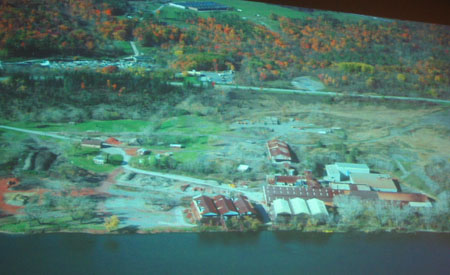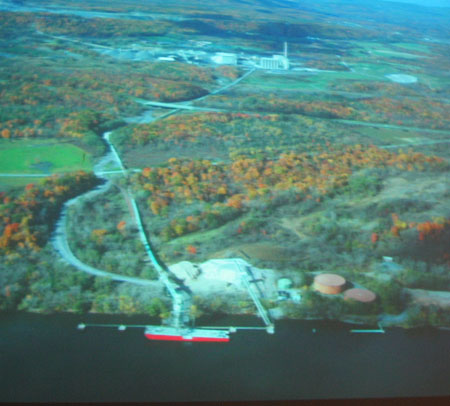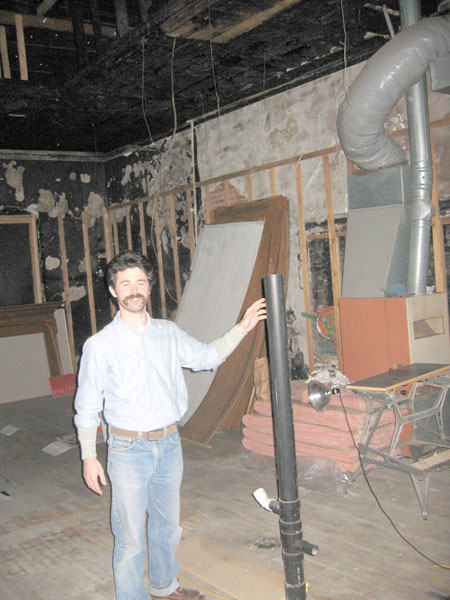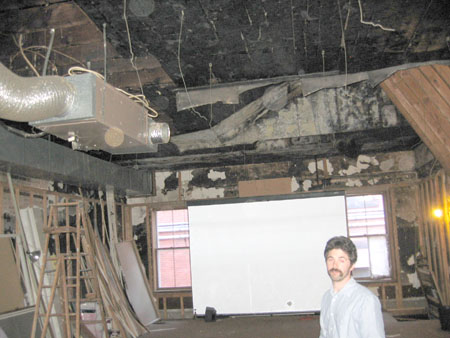|
|
|
ungentrified Troy
Saturday, October 7 2006
Zelig ("Mr. Tillson") picked me up today and we drove together up to Troy to see a geophotographic exhibit called "Up River" put together by some of his friends from back when he was in architecture school. These friends have bought a large brick building in downtown Troy (for only $50,000) and are proceeding apace with their plan to establish some sort of hybrid between an exhibition space and an intentional community. It is to be the eastern branch of a bicoastal urban landscape interactivity effort called "The Center for Land Use Interpretation."
On the drive north we stopped at a rest area and I got a cup of nasty machine-generated "capuccino," one of the roadtrip rituals I've developed since turning thirty. I would have also gotten a large order of fries, but the line at the McDonalds was choked with humanatees.
The exhibition was built on a long wall featuring a strip of standard 1:24,000 USGS topographic map representing the entire length of the tidal Hudson from Troy down to the Statue of Liberty. Into this map were numbered pushpins referring to nearby ærial photographs of various colossal manmade structures, most of them either mines or remnant concrete slabs from enormous factories. It turns out that the bulk of visible manmade activity along the Hudson involves either the production or consumption of concrete. Other grand projects involve the production of electricity, the destruction of trash, or a combination of both (waste incinerators).
Interestingly, the captions for the individual photos contained much better (and more informative) writing than did the central blurb for the entire exhibit, which was full of meaningless art museum expressions.
After we'd seen the exhibit, Zelig and I went on a self-guided tour of the rest of the building. It had an exceedingly stoutly-constructed, with floors made from a framework of I-beam joists spanned by shallow arches of brick. Into this Victorian-era framework, people working for the Center had nearly completed the construction of drywall galleries, office spaces crammed full of modern computer equipment, and a number of interesting lofted lounge areas, two of which were connected via a twenty foot long hands-and-knees-only tunnel. In the top floor of the building was a large space still awaiting remodeling. Its charred ceiling testified to a successfully-extinguished fire at some point in the past. (This was something I thought they should leave exposed, but they won't.)
Zelig and I hit a nearby Indian restaurant for lupper. While we were there, a group young adults came in to dine and I noticed that one of them was wearing an Ozzfest teeshirt. But they quickly showed themselves to be more college student than metalhead. Throughout their meal, they talked almost exclusively (and somewhat geekishly) about piercings and tattoos and the relative painfulness of getting them installed in various parts of the body. According to the Ozzfest guy, the knobby bone at the base of the back of the neck is a particularly painful place to get a tattoo.
After eating, Zelig and I wandered through Troy's downtown, which was surprisingly devoid of humanity given that it was a Saturday night. Evidently this is what a city is like when it has experienced zero gentrification.
Strong evidence for the weakness of Troy's gentrification can be seen down on the banks of the Hudson where State Street leads to a large docked river vessel. In most cities, one would find a pleasant sidewalk leading along the waterfront in both directions, and (on a sunny day like today) it would be full of joggers, gutterpunks, and mothers pushing babies in strollers. But on Troy's river bank there is no sidewalk. Indeed, there's no grass or any sort of walkable surface. If you try to walk south you find your way blocked by a particularly grim parking structure shouting "Form follows function and frequently flattens flowers!" And if you try to walk north, you find yourself in a dead-end parking lot. There is a short strip of antique stores along nearby River Street, but the people doing the antiquing today weren't flamers; they were overweight housewives dressed in pastels and sweat pants. This is why you can still buy a massive brick building there for only $50,000.

The photos were also being shown as an automated slide exhibit.

This is a concrete conveyance system passing beneath the Thruway to the Hudson a little south of Albany.


Zelig poses with the topmost floor in the $50,000 brick building. The ceiling above was charred by a fire.

A rotting interior.

Also somewhat ghostly. All included in the $50,000 price tag.

Scary vintage electric equipment.
For linking purposes this article's URL is:
http://asecular.com/blog.php?061007 feedback
previous | next |






